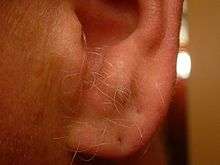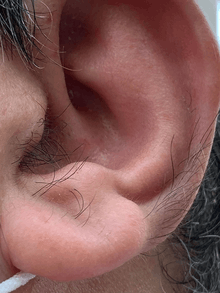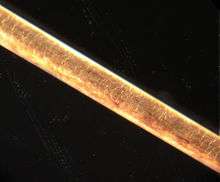Ear hair
Ear hair is the terminal hair arising from folliculary cartilage inside the external auditory meatus in humans.[1] In its broader sense, ear hair may also include the fine vellus hair covering much of the ear, particularly at the prominent parts of the anterior ear, or even the abnormal hair growth as seen in hypertrichosis and hirsutism. Medical research on the function of ear hair is currently very scarce.


Hair growth within the ear canal is often observed to increase in older men,[2]:206 together with increased growth of nose hair.[3] Visible hair that protrudes from the ear canal is sometimes trimmed for cosmetic reasons.[4]:97 Excessive hair growth within or on the ear is known medically as auricular hypertrichosis.[5]:125 Some men, particularly in the male population of India, have coarse hair growth along the lower portion of the helix, a condition referred to as "having hairy pinnae" (hypertrichosis lanuginosa acquisita).[6]
Structure

Hair is a protein filament that grows from follicles in the dermis, or skin. With the exception of areas of glabrous skin, the human body is covered in follicles which produce thick terminal and fine vellus hair. It is an important biomaterial primarily composed of protein, notably keratin.
Clinical significance
- Hair that migrates so that it touches the eardrum may cause tinnitus.[7]
- Folliculitis of ear hair may cause acute and localized otitis externa.[8]
- Severe hypertrichosis of the external ear during minoxidil therapy, where excessive hair covers the ears, may cause ear canal occlusion, potentially resulting in partial or complete deafness.[9]
Society and culture
Radhakant Bajpai, an Indian grocer, was recognized by Guinness in 2003 as having the longest ear hair in the world, measuring 13.2 cm. In a 2009 interview, when his hair had reached 25 cm, he said that he considered the long ear hair to be a symbol of luck and prosperity.[10]
References
- W. Steven Pray. "Swimmer's Ear: An Ear Canal Infection" (PDF). Naveh Ltd. Licensed Distributor of Medical Pharmaceuticals. Retrieved March 9, 2016.
- Leyner, Mark; Goldberg, Billy (July 26, 2005). Why Do Men Have Nipples?: Hundreds of Questions You'd Only Ask a Doctor After Your Third Martini. Crown Publishing Group. ISBN 9780307337047. Retrieved September 8, 2014 – via Google Books (preview).
- Nagourney, Eric (December 13, 2012). "Why Is Hair Growing Out of There?". The New York Times. Retrieved September 8, 2014.
- Livingston, Ruth (June 17, 2010). Advanced Public Speaking: Dynamics and Techniques. Xlibris Corporation. ISBN 9781453508039. Retrieved September 8, 2014 – via Google Books (preview).
- Jackson, Scott; Nesbitt, Lee T. (April 25, 2012). Differential Diagnosis for the Dermatologist. Springer Science & Business Media. ISBN 978-3-642-28006-1. Retrieved October 24, 2014 – via Google Books (preview).
- "Otoscopy: The Pinna". Hawke Library. Retrieved October 26, 2014.
- "Tinnitus Signs and Symptoms". UCSF Medical Center. University of California San Francisco. Retrieved 2014-10-28.
- Joseph P Garry (Feb 28, 2010). "Otitis externa". Medscape.com. Retrieved 2012-08-31.
- Toriumi, MD, Dean; Raymond, Konior, MD; Berktold, MD, Robert (August 1988). "Severe hypertrichosis of the external ear canal during minoxidil therapy". Arch Otolaryngol Head Neck Surg. 114: 918–9. doi:10.1001/archotol.1988.01860200102029. PMID 3390339.
- "Pictured: The man with the world's longest ear hair". Daily Mail Online. Daily Mail. 2009-02-17. Retrieved 2014-10-26.